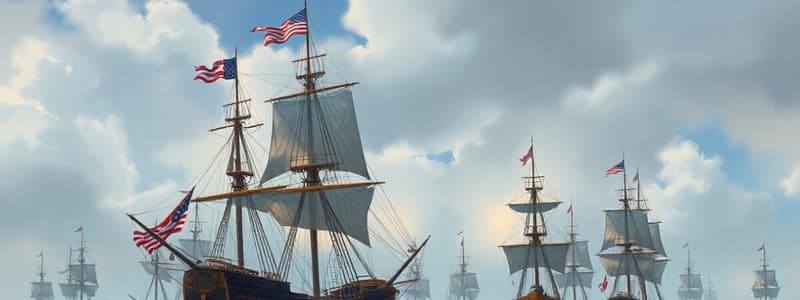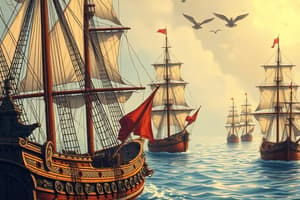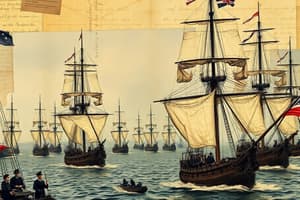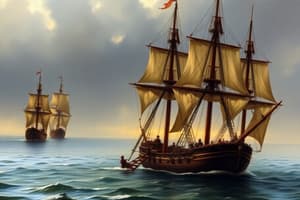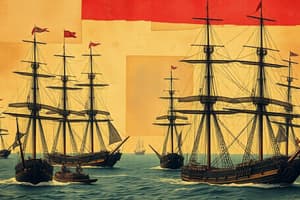Podcast
Questions and Answers
The American colonies began the American Revolution with what naval capability?
The American colonies began the American Revolution with what naval capability?
- A small, but well-equipped navy
- A limited naval force, mainly merchant vessels (correct)
- No naval force at all
- A large fleet of warships
What action delayed the British attack on Fort Ticonderoga, contributing to the American victory at Saratoga?
What action delayed the British attack on Fort Ticonderoga, contributing to the American victory at Saratoga?
- The French navy blockading British ports
- A surprise attack by American forces on Montreal
- A harsh winter that froze the lake
- Benedict Arnold's actions forcing the British to build a fleet on Lake Champlain (correct)
What key factor changed the naval dynamic of the American Revolution?
What key factor changed the naval dynamic of the American Revolution?
- Foreign intervention by France, Spain, and the Netherlands (correct)
- The invention of new naval technology
- The British withdrawing naval forces to fight elsewhere
- The Continental Navy winning a major sea battle
What was the primary focus of the Barbary Wars?
What was the primary focus of the Barbary Wars?
What action did President Jefferson take in response to the Bashaw of Tripoli demanding increased tribute?
What action did President Jefferson take in response to the Bashaw of Tripoli demanding increased tribute?
What was the significance of the American victory involving William Eaton and Hamet Karamanli?
What was the significance of the American victory involving William Eaton and Hamet Karamanli?
What event prompted President Madison to request war against Algiers?
What event prompted President Madison to request war against Algiers?
What commander ordered the burning of the Washington Navy Yard during the War of 1812?
What commander ordered the burning of the Washington Navy Yard during the War of 1812?
Which U.S. frigate earned the nickname "Old Ironsides" during a battle in the War of 1812?
Which U.S. frigate earned the nickname "Old Ironsides" during a battle in the War of 1812?
Who commanded the U.S. Navy squadron that secured Lake Erie during the War of 1812?
Who commanded the U.S. Navy squadron that secured Lake Erie during the War of 1812?
What strategic role did the Navy play in the Mexican-American War?
What strategic role did the Navy play in the Mexican-American War?
Under what commodores did the Pacific Squadron secure the California campaign in the Mexican-American War?
Under what commodores did the Pacific Squadron secure the California campaign in the Mexican-American War?
What was the primary goal of the Union blockade during the Civil War?
What was the primary goal of the Union blockade during the Civil War?
What was the name of the Confederate ironclad that was originally the USS Merrimack?
What was the name of the Confederate ironclad that was originally the USS Merrimack?
What was the name of the Union ironclad built to counter the Confederate ironclad threat?
What was the name of the Union ironclad built to counter the Confederate ironclad threat?
The USS Monitor's primary armament consisted of what?
The USS Monitor's primary armament consisted of what?
What marked the end of the age of sail and facilitated a new age of U.S. involvement in global naval operations?
What marked the end of the age of sail and facilitated a new age of U.S. involvement in global naval operations?
What event directly preceded the Spanish-American War?
What event directly preceded the Spanish-American War?
During the Spanish-American War, what did Secretary of the Navy John D. Long order Captain Henry Glass to do?
During the Spanish-American War, what did Secretary of the Navy John D. Long order Captain Henry Glass to do?
What was the main purpose of the Great White Fleet's voyage around the world?
What was the main purpose of the Great White Fleet's voyage around the world?
What was the primary target of the Japanese attack on Pearl Harbor?
What was the primary target of the Japanese attack on Pearl Harbor?
What was a significant outcome of the Battle of the Coral Sea?
What was a significant outcome of the Battle of the Coral Sea?
What was the Japanese's main objective in targeting Midway Island?
What was the Japanese's main objective in targeting Midway Island?
What crucial role did American cryptanalysts play before the Battle of Midway?
What crucial role did American cryptanalysts play before the Battle of Midway?
What was the strategic significance of the Allied victory on Guadalcanal?
What was the strategic significance of the Allied victory on Guadalcanal?
What was the primary goal of the U.S. military in targeting Iwo Jima during World War II?
What was the primary goal of the U.S. military in targeting Iwo Jima during World War II?
What was the main Japanese strategy at Iwo Jima?
What was the main Japanese strategy at Iwo Jima?
What overall objective were the Japanese 'Sho' (Victory) plans designed to achieve?
What overall objective were the Japanese 'Sho' (Victory) plans designed to achieve?
What was the ultimate fate of the USS Indianapolis after delivering its important cargo?
What was the ultimate fate of the USS Indianapolis after delivering its important cargo?
What was the initial U.S. policy at the start of the Battle of the Atlantic?
What was the initial U.S. policy at the start of the Battle of the Atlantic?
What action triggered the authorization for the U.S. Navy to fire upon German U-boats before the U.S.'s official entry into World War II?
What action triggered the authorization for the U.S. Navy to fire upon German U-boats before the U.S.'s official entry into World War II?
What tactic was used by the USS Texas (BB-35) during the Normandy invasion to increase its firing range?
What tactic was used by the USS Texas (BB-35) during the Normandy invasion to increase its firing range?
What was the status of the U.S. Navy fleet between the end of WWII and the opening of the Korean War?
What was the status of the U.S. Navy fleet between the end of WWII and the opening of the Korean War?
What was the name of the U.N. assault, led by the U.S. Navy, designed to force North Korean forces to retreat from South Korea?
What was the name of the U.N. assault, led by the U.S. Navy, designed to force North Korean forces to retreat from South Korea?
What naval action took place on September 13, 1950, as part of JTF 7, under Admirals Struble and Doyle related to the invasion of Inchon?
What naval action took place on September 13, 1950, as part of JTF 7, under Admirals Struble and Doyle related to the invasion of Inchon?
What was Operation Passage to Freedom during the Vietnam War?
What was Operation Passage to Freedom during the Vietnam War?
The Gulf of Tonkin incident led to which of the following?
The Gulf of Tonkin incident led to which of the following?
What was the purpose of Operation Market Time during the Vietnam War?
What was the purpose of Operation Market Time during the Vietnam War?
What was the location of Yankee Station during the Vietnam War?
What was the location of Yankee Station during the Vietnam War?
Why was the USS Pueblo seized by North Korean forces?
Why was the USS Pueblo seized by North Korean forces?
What was the ultimate fate of the USS Pueblo?
What was the ultimate fate of the USS Pueblo?
Flashcards
Initial Naval Weakness
Initial Naval Weakness
The American colonies started with a limited naval force, relying mainly on merchant vessels.
Disruption of British Commerce
Disruption of British Commerce
American privateers and naval ships significantly disrupted British trade, leading to increased marine insurance rates and appeals to the Crown from British merchants to end the war.
Creation of Continental Navy
Creation of Continental Navy
The Continental Congress authorized the creation of the Continental Navy in October 1775.
British Losses in American Revolution
British Losses in American Revolution
Signup and view all the flashcards
Foreign Intervention in American Revolution
Foreign Intervention in American Revolution
Signup and view all the flashcards
End of the American Revolution
End of the American Revolution
Signup and view all the flashcards
The Barbary Wars
The Barbary Wars
Signup and view all the flashcards
Second Barbary War (Algerian War)
Second Barbary War (Algerian War)
Signup and view all the flashcards
Burning of Washington Navy Yard
Burning of Washington Navy Yard
Signup and view all the flashcards
Constitution vs. HMS Guerriere
Constitution vs. HMS Guerriere
Signup and view all the flashcards
U.S. frigate United States vs. British frigate Macedonian
U.S. frigate United States vs. British frigate Macedonian
Signup and view all the flashcards
Battle of Lake Erie
Battle of Lake Erie
Signup and view all the flashcards
Gulf of Mexico (Mexican-American War)
Gulf of Mexico (Mexican-American War)
Signup and view all the flashcards
Vera Cruz (Mexican-American War)
Vera Cruz (Mexican-American War)
Signup and view all the flashcards
Civil War Blockades
Civil War Blockades
Signup and view all the flashcards
Riverine Warfare (Civil War)
Riverine Warfare (Civil War)
Signup and view all the flashcards
Diplomacy (Civil War)
Diplomacy (Civil War)
Signup and view all the flashcards
Amphibious Assaults (Civil War)
Amphibious Assaults (Civil War)
Signup and view all the flashcards
Attack on Pearl Harbor
Attack on Pearl Harbor
Signup and view all the flashcards
Battle of the Coral Sea
Battle of the Coral Sea
Signup and view all the flashcards
Battle of Midway: American cryptanalysts
Battle of Midway: American cryptanalysts
Signup and view all the flashcards
Battle of Iwo Jima: Background
Battle of Iwo Jima: Background
Signup and view all the flashcards
Post WWII Navy
Post WWII Navy
Signup and view all the flashcards
Operation Market Time
Operation Market Time
Signup and view all the flashcards
Operation Rolling Thunder
Operation Rolling Thunder
Signup and view all the flashcards
USS Pueblo
USS Pueblo
Signup and view all the flashcards
Study Notes
American Revolution
- The American colonies started with a small naval force relying on merchant vessels.
- American privateers and ships disrupted British trade, leading to increased marine insurance rates and British merchants appealing to the Crown to end the war.
- In October 1775, the Continental Congress authorized the creation of the Continental Navy.
- By the end of 1777, American privateers and naval ships had captured over 500 British vessels, totaling about 1,500 by the war's end.
- The Continental Navy achieved early victories despite being outnumbered, including a raid on a British colony in the Bahamas.
- Benedict Arnold's actions on Lake Champlain forced the British to build a fleet, delaying their attack on Fort Ticonderoga, contributing to the victory at Saratoga.
- American naval actions forced the British to allocate resources, stretching their naval capacity.
- The entry of France, Spain, and the Netherlands into the war altered the naval dynamic.
- French naval superiority and reinforcements were crucial in defeating the British at Yorktown.
- Great Britain recognized the independence of the United States with the signing of the Peace of Paris on September 3, 1783.
The Barbary Wars
- The Barbary Wars (1801-1805 and 1815) involved the United States combating piracy by the Barbary States of North Africa.
- The Bashaw of Tripoli demanded increased tribute from the U.S., leading to the First Barbary War.
- President Jefferson responded by sending a Navy squadron to blockade Tripoli.
- American victories in the First Barbary War included those by the Enterprise and the burning of the frigate Philadelphia.
- Army Captain William Eaton led a raid with Hamet Karamanli to capture Derna.
- Victory in the First Barbary War resulted in a peace treaty where the United States no longer needed to pay tribute to Tripoli.
- After the War of 1812, President Madison requested war against Algiers because they sided with the British, instigating the Second Barbary War.
- Decatur's squadron inflicted damage on Algiers securing the end of tribute payments and the release of enslaved Americans.
- The defeat of Algiers marked the decline of Barbary pirate dominance, although piracy persisted to some extent.
- French conquest of Algeria in 1830 significantly diminished the Barbary States' power.
War of 1812
- The American Navy secured early victories in the Atlantic and on the Great Lakes.
- To prevent it from falling into enemy hands, Commodore Thomas Tingey ordered the burning of the Washington Navy Yard.
- A U.S. Navy squadron defeated a British flotilla on Lake Champlain.
- The Royal Navy bombarded Fort McHenry during the Defense of Baltimore, but the fort's defenders prevailed, and the British fleet withdrew.
- Captain Isaac Hull commanded the U.S. frigate Constitution in its defeat of HMS Guerriere, earning it the nickname "Old Ironsides".
- Captain Stephen Decatur, Jr. commanded the U.S. frigate United States in its defeat of British frigate Macedonian in a two-hour battle.
- Commodore William Bainbridge commanded the Constitution when it defeated HMS Java in a three-hour battle.
- Master Commandant Oliver Hazard Perry led a U.S. Navy squadron to secure Lake Erie after a three-hour engagement with a British flotilla.
- As the British Royal Navy blockaded U.S. ports, the frigate Chesapeake escaped from Boston Harbor but engaged HMS Shannon
- The Royal Navy defeated the American frigate Essex.
- The U.S. Army, militia, and Navy sailors repulsed British forces at the Battle of New Orleans.
- The war's last naval engagement was the capture of a British merchant vessel by sloop-of-war USS Peacock off Java in June.
Mexican-American War
- The Navy played a role through blockades and operations on both the Pacific coast and Gulf of Mexico.
- Commodores John Sloat and Robert Stockton secured the California campaign, leading to the U.S. claiming Monterey, San Francisco, and San Diego.
- Commodore Matthew Perry navigated Mexican rivers and waterways to capture enemy strongholds and disrupt supply lines.
- Commodore Matthew Perry collaborated with General Winfield Scott to land over 22,000 troops in Vera Cruz in March 1847.
- Coordination achieved the swift capture of Mexico City following the Vera Cruz landings, with the U.S. Naval battery participating in the bombardment of Vera Cruz.
Civil War
- The U.S. Navy played a significant role.
- The Navy patrolled 3,000 miles of coastline to cut off Confederate trade, aiming to cripple its economy and disrupt internal transportation.
- Naval objectives included controlling interior waterways, engaging Confederate fortifications on rivers like the Mississippi and James.
- Confederate cruisers targeted Union merchant ships on the high seas to damage the Northern economy and weaken support for the war.
- The USS Kearsarge sank the CSS Alabama off the coast of France.
- The USS Alliance rammed and sank the Florida in Hampton Roads.
- Naval actions influenced international relations, with European powers concerned about recognizing the Confederacy.
- The Navy supported the capture of key Southern ports and coastal areas through amphibious assaults.
The Clash of the Ironclads
- Union forces abandoned the Gosport Navy Yard, but Commodore Charles McCauley ordered it burned to prevent war supplies from falling into Confederate control.
- The burning of the Gosport Navy Yard was insufficient.
- The Confederates refloated the damaged hull of the Merrimack and transformed it into the CSS Virginia, a casemate ironclad with a deep draft from the added iron plating.
- Limited iron supply slowed the construction of the ironclad.
- As word spread of the Confederacy's plans for Merrimack, the Federals established the ironclad board, with the USS Monitor becoming a reality.
- The USS Monitor had a very low freeboard and carried two 11-inch Dahlgren smoothbore cannons in a rotating turret.
- The USS Monitor launched from the New York Navy Yard.
Battle of the Iron Clads: Day 1
- On March 8, 1862, the CSS Virginia with the CSS Beaufort and CSS Raleigh sailed to Hampton Roads to break the Union blockade.
- The CSS Virginia rammed and sank the USS Cumberland while shots from the USS Congress bounced off the thick armor of the Confederate ironclad.
- The CSS Beaufort fired at the Congress as the Confederate fleet approached, and the CSS Virginia fired a broadside before continuing on to engage the Cumberland
- The CSS Virginia rammed the Cumberland again sinking it and fired again drawing back.
- The USS Congress was hit by the CSS Virginia and ran aground before being burned.
- CSS Jamestown and CSS Patrick Henry, along with the Virginia, attempted to engage the grounded USS Minnesota, but the depth was too great for them to get closer than a mile.
- The Confederates withdrew from the crippled frigates and moved to Sewell's Point in the night.
Battle of the Iron Clads: Day 2
- On the morning of March 9, 1862, the CSS Virginia came out to finish the battle, heading towards the USS Minnesota.
- The USS Monitor appeared and opened fire, causing the CSS Jamestown and CSS Patrick Henry to retreat, but Virginia remained to face the Monitor.
- The two ironclad ships circled each other and exchanged fire for 4 hours.
- Neither ship inflicted a fatal blow due to the iron armor and both received damage.
- USS Monitor and CSS Virginia withdrew from battle.
Battle of the Iron Clads: Aftermath
- The USS Monitor was ordered to protect the USS Minnesota and stayed until tugs freed it from the shoal.
- The CSS Virginia returned to the yard for repairs but was unable to appear the following day and was scuttled in the James River because its draft was too deep.
The Steam Navy
- The U.S. Navy experimented with steam-powered ships as early as the War of 1812.
- In the 1840s, the Navy began incorporating steam propulsion into regular warships.
- With its advanced design and armament the ironclad Monitor ushered in a new age for naval warships.
- The need for rapid expansion and innovation of naval ships during the Civil War in the 1860s led to the first warships that did not use sails.
- John Dahlgren adapted the French steam engine for the U.S. Navy, improving its reliability and safety.
- Many steam-powered ships still used sails for auxiliary propulsion during the transition period, acting as fuel-saving options on long voyages.
- In 1882 Congress authorized the construction of steel warships powered by steam and carrying heavy guns on rotating turrets.
- The new steel Navy marked the end of the age of sail and a new age of U.S. involvement in global naval operations.
Spanish-American War
- Spain declared war on the United States on April 24, which prompted Congress to declare a state of war existed from April 21.
- The U.S. Navy blockaded ports in Cuba after the battleship Maine unexpectedly exploded and sank in Havana harbor on February 15, 1898, killing 266 American sailors.
- The U.S. Navy under Admirals William T. Sampson and Winfield S. Schley successfully blockaded the port of Santiago.
- Commodore George Dewey's Asiatic Squadron destroyed the Spanish squadron in Manila Bay.
- Schley's squadron destroyed Spanish ships in the Battle of Santiago Bay, including torpedo boat Plutón and armored cruisers Infanta María Teresa, Vizcaya, and Cristóbal Colón.
- Secretary of the Navy John D. Long ordered Captain Henry Glass to capture Guam.
The Great White Fleet
- President Theodore Roosevelt sent the Great White Fleet around the world from December 16, 1907, to February 22, 1909, to show American sea power.
- The fleet consisted of 16 new battleships, was painted white, and manned by 14,000 sailors.
- The fleet covered 43,000 miles with twenty port calls on six continents, under Rear Admiral Robley D. Evans (later Charles S. Sperry).
- The fleet sailed from Hampton Roads, Virginia, visiting locations including Trinidad, Brazil, Chile, Peru, Mexico, Hawaii, New Zealand, Australia, Philippines, Japan, Ceylon and Egypt, offering aid in Sicily after an earthquake, and being reviewed by President Roosevelt upon return to Hampton Roads.
WWII Pacific Fleet: Attack on Pearl Harbor
- On Sunday morning, December 7, 1941, the Imperial Japanese Navy launched a surprise attack on the U.S. Pacific Fleet at Pearl Harbor.
- Japanese carrier attack planes, including torpedo and high-level bombers, supported by fighters, struck in two waves.
- Targets included naval and military airfields and bases in addition to the U.S Pacific Fleet.
- The enemy sank battleships and other ships, suffering damage to Navy, Army, and Marine Corps facilities, destroying many airplanes, and causing many casualties.
- American technological skill repaired all ships except three at Pearl Harbor.
- The attack united the nation and spurred a commitment to victory in World War II.
WWII Pacific Fleet: Battle of the Coral Sea
- The Battle of the Coral Sea was a significant naval engagement fought between the United States with Australian forces against the Japanese.
- The Japanese aimed to capture Tulagi and Port Moresby advancing south and southeastward.
- Between April 29 and May 4, Japanese forces attacked, invaded, and occupied Tulagi.
- Alerted to the presence of carriers the Japanese Carrier Strike Force advanced toward the Coral Sea to destroy Allied naval forces.
- Beginning on May 7, the two sides exchanged air strikes over two days.
- Japan sank USS Lexington, USS Sims, and USS Neosho, and damaged the Yorktown.
- Japan only lost one small carrier (Shoho) and suffered damage to a fleet carrier (Shokaku) and Allied forces withdrew from the operational area.
- The Japanese advance was checked, although they captured Tulagi but they were unable to capture Port Moresby.
- The severe damage to the Shokaku and the loss of pilots and planes on the Zuikaku reduced Japanese carrier availability by a third.
- The Battle of the Coral Sea was the first time since Pearl Harbor that the Japanese advance was checked, and the first naval engagement where participating ships never sighted or fired directly at each other.
WWII Pacific Fleet: Battle of Midway, 4-7 June 1942
- The Japanese targeted Midway to establish an eastern shield of defenses in the Central Pacific to pursue their Asian policies.
- The plan was to draw out and destroy U.S. Pacific Fleet carriers and battleship task forces.
- Success would eliminate the Pacific Fleet for at least a year and provide a forward outpost for future threat warnings.
- American cryptanalysts broke the Japanese navy's code and identified "AF" as Midway and predicted the attack on June 4.
- Based on intercepts, Admiral Nimitz planned countermeasures and reinforced forces on Midway.
- On June 3, American land-based aircraft located and attacked Japanese transports about 600 miles west of Midway Island.
- On June 4, Japanese carrier aircraft bombed Midway installations during initial air attacks.
- Torpedo bombers from American carriers attacked the Japanese carriers, drawing off enemy aircraft but were mostley wiped out in the process.
- Dive bombers from USS Enterprise bombed and fatally damaged carriers Kaga and Akagi as SBDs from Yorktown bombed and wrecked carrier Soryu.
- The Japanese carrier Hiryu launched dive bombers that temporarily disabled the Yorktown
- Dauntlessess from Enterprise damaged Hiryu who sunk around 1700 that afternoon as well.
- Japanese submarine I-168 torpedoed the Yorktown and sank destroyer USS Hammann (DD-412) on June 6 and the Yorktown sank at dawn on June 7.
- The U.S. Navy inflicted a defeat on the Imperial Japanese Navy resulting in the U.S. losing one carrier and Japan losing four.
WWII Pacific Fleet: The Guadalcanal Campaign
- Took place from August 1942 to February 1943 and involved multiple battles and events.
- On 7-8 August 1942, the U.S. Navy’s 1st Marine Division made initial landings on Guadalcanal and Tulagi in the eastern Solomons.
- On 9 August 1942, the Imperial Japanese Navy launched a night surface attack on Allied ships near Savo Island resulting in a surprise and significant defeat in the Battle of Savo Island.
- U.S. and Japanese ships engaged in attacks via carrier-based or shore-based aircraft during Operation Ka in the Battle of the Eastern Solomons (23–25 August 1942).
- On 11 October 1942 near Guadalcanal, a U.S. task force commanded by Rear Admiral Norman Scott surprised Japanese cruisers and destroyers in the Battle of Cape Esperance.
- The Japanese ships were on a mission to bombard Henderson Field before being engages by U.S forces.
- The U.S. forces sunk one Japanese cruiser and one destroyer, with another cruiser badly damaged resulting in a morale boost to the navy after a past defeat.
- One destroyed was sunk along with one cruiser damaged as the Japanese abandoned their bombardment mission but the supply convoy successfully reached Guadalcanal.
- U.S sank Japanese ships and aircraft confronted each other during the Battle of Santa Cruz Islands (26 October 1942) as U.S. forces halted a Japanese ground offensive.
- A series of air and sea engagements occurred from 12–15 November 1942 as the Japanese tried to reinforce their ground forces, ultimately preventing the Japanese bombardment and troop transports.
- On 30 November 1942 a US naval force attempted to surprise and destroyed Japanese destroyers dispatched to resupply ground forves in the Battle of Tassafaronga.
- Surface radar was utilized enabling the location and sinking of a Japanese destroyer.
- Japanese warships reacted quickly and sunk one U.S. cruiser and damaging three others, avoiding the delivery of their supplies and reinforcements.
- Operation Ke was executed during the Japanese Withdrawal in February 1943 due to the lack of ammunition, food, and reinforcements, resulting in an Allied turning point by gaining land.
- Following the Battle of Midway, the Allied victory on Guadalcanal marked a turning point, putting Japan on the defensive.
WWII: The Battle of Iwo Jima
- This was a major campaign between the U.S. and Japan.
- The U.S. military sought airfields on Iwo Jima to secure airfields for fighter escorts and emergency landings for bombing missions over Japan.
- Intense bombing raids and naval bombardment by U.S. forces commenced for three days before troops first assaulted the beaches, defended by General Tadamichi Kuribayashi, utilizing tunnels and fortified positions.
- Despite the need for long range radar. Allied planners had thought that the radar station at Iwo Jima was useless.
- Japan aimed not to win, but to delay defeat and inflict high cost on the enemy resulting on the death of many soilders on both sides.
- Under General Kuribayashi's new methods, the Japanese discouraged banzai attacks and focused on delaying the enemy and inflicting high casualties.
- The battle commenced February 19, 1945 with Fifth Fleet initiating an amphibious assault .
- Intense warfare ensued between U.S. marines and Japanese.
- The 5th Marine Division isolated Mount Suribachi and the 4th Marine Division advanced towards the airfields.
- On February 23, 1945, Mount Suribachi was captured and the airfields were deemed secured .
Studying That Suits You
Use AI to generate personalized quizzes and flashcards to suit your learning preferences.
